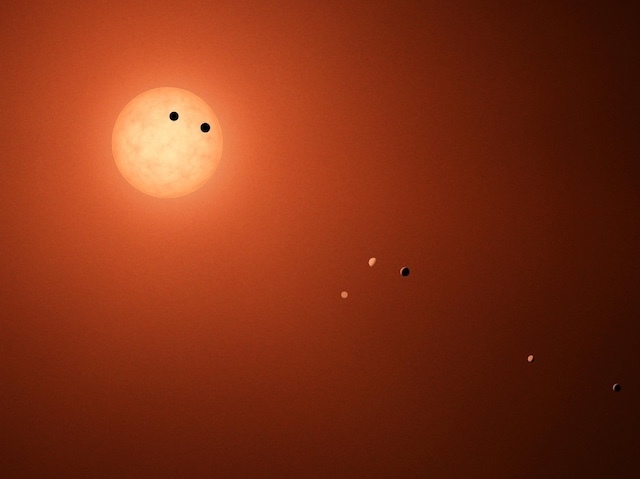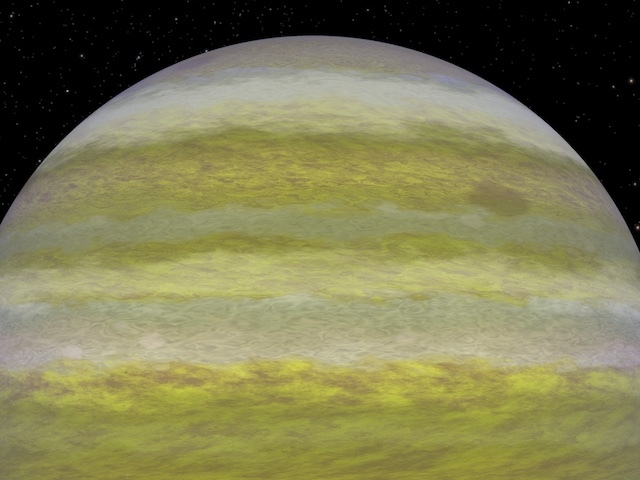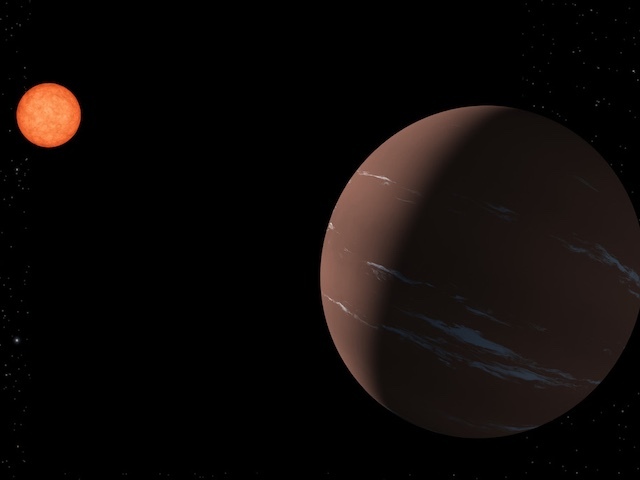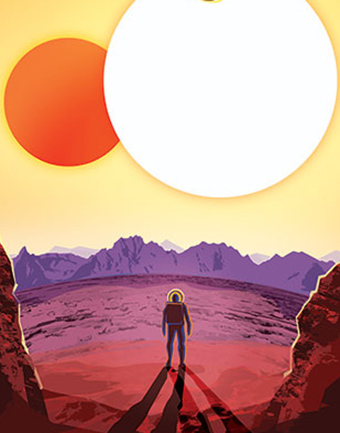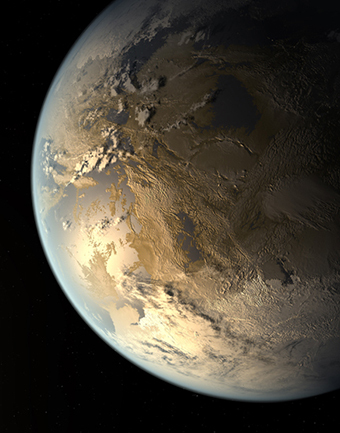News | February 5, 2018
New clues to compositions of TRAPPIST-1 planets

This artist's concept shows what the TRAPPIST-1 planetary system may look like, based on available data about the planets' diameters, masses and distances from the host star, as of February 2018. Credit: NASA/JPL-Caltech
The seven Earth-size planets of TRAPPIST-1 are all mostly made of rock, with some having the potential to hold more water than Earth, according to a new study published in the journal Astronomy and Astrophysics. The planets' densities, now known much more precisely than before, suggest that some planets could have up to 5 percent of their mass in water – which is 250 times more than the oceans on Earth.
The form that water would take on TRAPPIST-1 planets would depend on the amount of heat they receive from their star, which is a mere 9 percent as massive as our Sun. Planets closest to the star are more likely to host water in the form of atmospheric vapor, while those farther away may have water frozen on their surfaces as ice. TRAPPIST-1e is the rockiest planet of them all, but still is believed to have the potential to host some liquid water.
"We now know more about TRAPPIST-1 than any other planetary system apart from our own," said Sean Carey, manager of the Spitzer Science Center at Caltech/IPAC in Pasadena, California, and co-author of the new study. "The improved densities in our study dramatically refine our understanding of the nature of these mysterious worlds."
Since the extent of the system was revealed in February 2017, researchers have been working hard to better characterize these planets and collect more information about them. The new study offers better estimates than ever for the planets' densities.
What is TRAPPIST-1?
TRAPPIST-1 is named for the Transiting Planets and Planetesimals Small Telescope (TRAPPIST) in Chile, which discovered two of the seven planets we know of today – announced in 2016. NASA's Spitzer Space Telescope, in collaboration with ground-based telescopes, confirmed these planets and uncovered the other five in the system.
Since then, NASA's Kepler space telescope has also observed the TRAPPIST-1 system, and Spitzer began a program of 500 additional hours of TRAPPIST-1 observations, which will conclude in March. This new body of data helped study authors paint a clearer picture of the system than ever before – although there is still much more to learn about TRAPPIST-1.
More: Hubble probes atmospheres of exoplanets in TRAPPIST-1 habitable zone
The TRAPPIST-1 planets huddle so close to one another that a person standing on the surface of one of these worlds would have a spectacular view of the neighboring planets in the sky. Those planets would sometimes appear larger than the Moon looks to an observer on Earth. They may also be tidally locked, meaning the same side of the planet is always facing the star, with each side in perpetual day or night. Although the planets are all closer to their star than Mercury is to the Sun, TRAPPIST-1 is such a cool star, some of its planets could still, in theory, hold liquid water.
In the new study, scientists led by Simon Grimm at the University of Bern in Switzerland created computer models to better simulate the planets based on all available information. For each planet, researchers had to come up with a model based on the newly measured masses, the orbital periods and a variety of other factors – making it an extremely difficult, "35-dimensional problem," Grimm said. It took most of 2017 to invent new techniques and run simulations to characterize the planets' compositions.
What might these planets look like?
It is impossible to know exactly how each planet looks, because they are so far away. In our own solar system, the Moon and Mars have nearly the same density, yet their surfaces appear entirely different.
"Densities, while important clues to the planets' compositions, do not say anything about habitability. However, our study is an important step forward as we continue to explore whether these planets could support life," said Brice-Olivier Demory, co-author at the University of Bern.
Based on available data, here are scientists' best guesses about the appearances of the planets:
TRAPPIST-1b, the innermost planet, is likely to have a rocky core, surrounded by an atmosphere much thicker than Earth's. TRAPPIST-1c also likely has a rocky interior, but with a thinner atmosphere than planet b. TRAPPIST-1d is the lightest of the planets – about 30 percent the mass of Earth. Scientists are uncertain whether it has a large atmosphere, an ocean or an ice layer – all three of these would give the planet an "envelope" of volatile substances, which would make sense for a planet of its density.
Scientists were surprised that TRAPPIST-1e is the only planet in the system slightly denser than Earth, suggesting it may have a denser iron core than our home planet. Like TRAPPIST-1c, it does not necessarily have a thick atmosphere, ocean or ice layer – making these two planets distinct in the system. It is mysterious why TRAPPIST-1e has a much rockier composition than the rest of the planets. In terms of size, density and the amount of radiation it receives from its star, this is the most similar planet to Earth.
TRAPPIST-1f, g and h are far enough from the host star that water could be frozen as ice across these surfaces. If they have thin atmospheres, they would be unlikely to contain the heavy molecules of Earth, such as carbon dioxide.
"It is interesting that the densest planets are not the ones that are the closest to the star, and that the colder planets cannot harbor thick atmospheres," said Caroline Dorn, study co-author based at the University of Zurich, Switzerland.
How do we know?
Scientists are able to calculate the densities of the planets because they happen to be lined up such that when they pass in front of their star, our Earth- and space-based telescopes can detect a dimming of its light. This is called a transit. The amount by which the starlight dims is related to the radius of the planet.
To get the density, scientists take advantage of what are called "transit timing variations." If there were no other gravitational forces on a transiting planet, it would always cross in front of its host star in the same amount of time – for example, Earth orbits the Sun every 365 days, which is how we define one year. But because the TRAPPIST-1 planets are packed so close together, they change the timing of each other's "years" ever so slightly. Those variations in orbital timing are used to estimate the planets' masses. Then, mass and radius are used to calculate density.
Next Steps
The next step in exploring TRAPPIST-1 will be NASA's James Webb Space Telescope, which will be able to delve into the question of whether these planets have atmospheres and, if so, what those atmospheres are like. A recent study using NASA's Hubble Space Telescope found no detection of hydrogen-dominated atmospheres on planets TRAPPIST-1d, e and f – another piece of evidence for rocky composition – although the hydrogen-dominated atmosphere cannot be ruled out for g.
Illustrations of these worlds will change as ongoing scientific investigations home in on their properties.
"Our conceptions of what these planets look like today may change dramatically over time," said Robert Hurt, senior visualization scientist at the Spitzer Science Center. "As we learn more about these planets, the pictures we make will evolve in response to our improved understanding.
For more information about TRAPPIST-1, visit:


